Semiconductor testing company FormFactor (NASDAQ:FORM) reported results ahead of analysts' expectations in Q4 FY2023, with revenue up 1.3% year on year to $168.2 million. On the other hand, the company expects next quarter's revenue to be around $165 million, slightly below analysts' estimates. It made a non-GAAP profit of $0.20 per share, improving from its profit of $0.05 per share in the same quarter last year.
FormFactor (FORM) Q4 FY2023 Highlights:
- Revenue: $168.2 million vs analyst estimates of $165.3 million (1.7% beat)
- EPS (non-GAAP): $0.20 vs analyst expectations of $0.20 (small miss)
- Revenue Guidance for Q1 2024 is $165 million at the midpoint, below analyst estimates of $166.2 million
- Free Cash Flow was -$310,000, down from $14.65 million in the previous quarter
- Inventory Days Outstanding: 101, up from 99 in the previous quarter
- Gross Margin (GAAP): 40.4%, up from 30.6% in the same quarter last year
- Market Capitalization: $2.97 billion
With customers across the foundry and fabless markets, FormFactor (NASDAQ:FORM) is a US-based provider of test and measurement technologies for semiconductors.
FormFactor was founded in 1993 by former IBM researcher, Igor Khandros. The initial products served three semiconductor applications: sockets, packaging, and probe cards. FormFactor went public in June of 2003.
Designing semiconductors involves modeling, reliability testing, and design de-bug followed by qualification and production assessments. Along the way, testing and measurement occurs to ensure compliance with industry standards and to ensure accuracy. Since semiconductor manufacturing is a complex and resource-intensive process, detecting flaws early in the process means saving money and time. As such, testing and measurement impact yields, time-to-market, and overall quality.
FormFactor’s products – often customized to meet customers’ unique wafer and chip designs – address these testing and measurement needs through products such as probe cards, probe stations, thermal systems, and cryogenic systems. Probe cards, for example, ensure that a customer’s composite contact elements used in manufacturing are precise to length scales of a few microns and reliable across various compression levels. Thermal systems ensure precise temperature management during certain steps in semiconductor manufacturing.
Competitors in the market for probe cards, FormFactor’s largest product category, include Advanced Micro Silicon Technology, Chungwa Precision Test Technology, Feinmetall, and Japan Electronic Materials Corporation (TYO:6855).Sales Growth
FormFactor's revenue has been declining over the last three years, dropping by 0.5% on average per year. As you can see below, this was a weaker quarter for the company, with revenue growing from $166 million in the same quarter last year to $168.2 million. Semiconductors are a cyclical industry, and long-term investors should be prepared for periods of high growth followed by periods of revenue contractions (which can sometimes offer opportune times to buy).
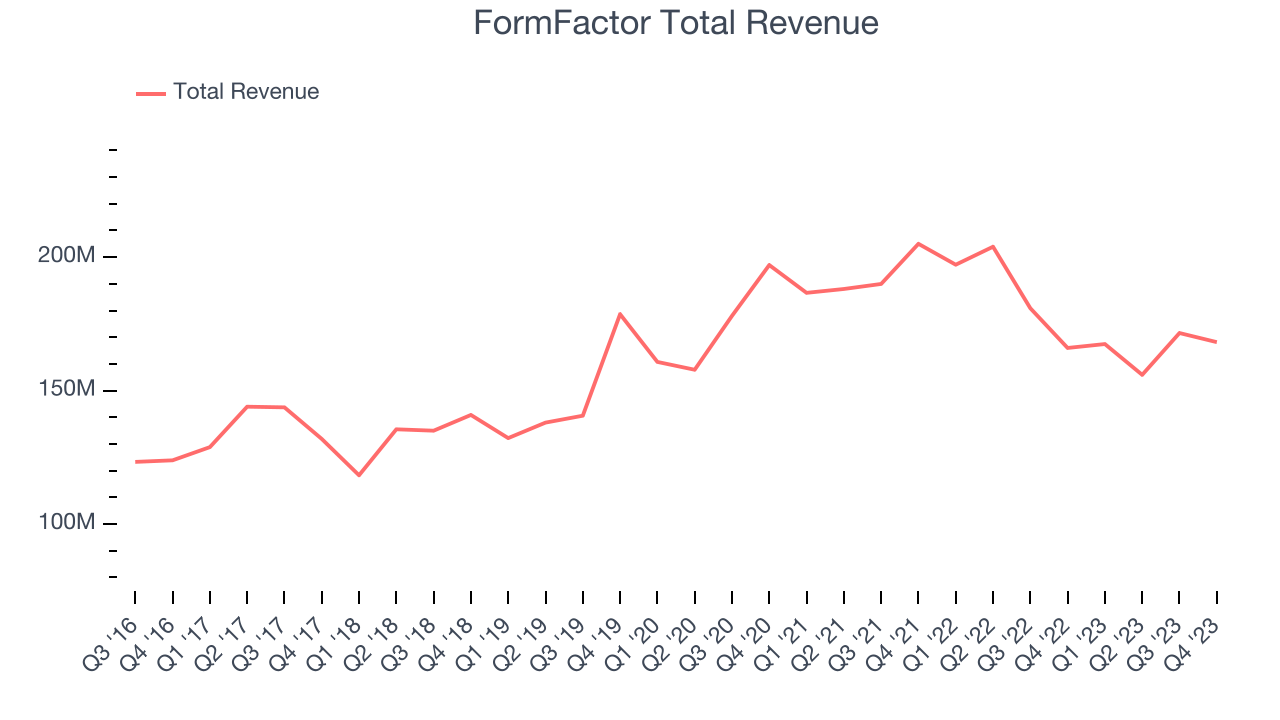
While FormFactor beat analysts' revenue estimates, this was a sluggish quarter for the company as its revenue only grew 1.3% year on year. FormFactor's growth, however, flipped from negative to positive this quarter. This encouraging sign will likely be welcomed by shareholders.
Although FormFactor returned to positive revenue growth this quarter, its management team expects revenue to decline 1.5% next quarter. On the other hand, Wall Street expects the favorable trend to continue, projecting 8.5% revenue growth over the next 12 months.
Product Demand & Outstanding Inventory
Days Inventory Outstanding (DIO) is an important metric for chipmakers, as it reflects a business' capital intensity and the cyclical nature of semiconductor supply and demand. In a tight supply environment, inventories tend to be stable, allowing chipmakers to exert pricing power. Steadily increasing DIO can be a warning sign that demand is weak, and if inventories continue to rise, the company may have to downsize production.
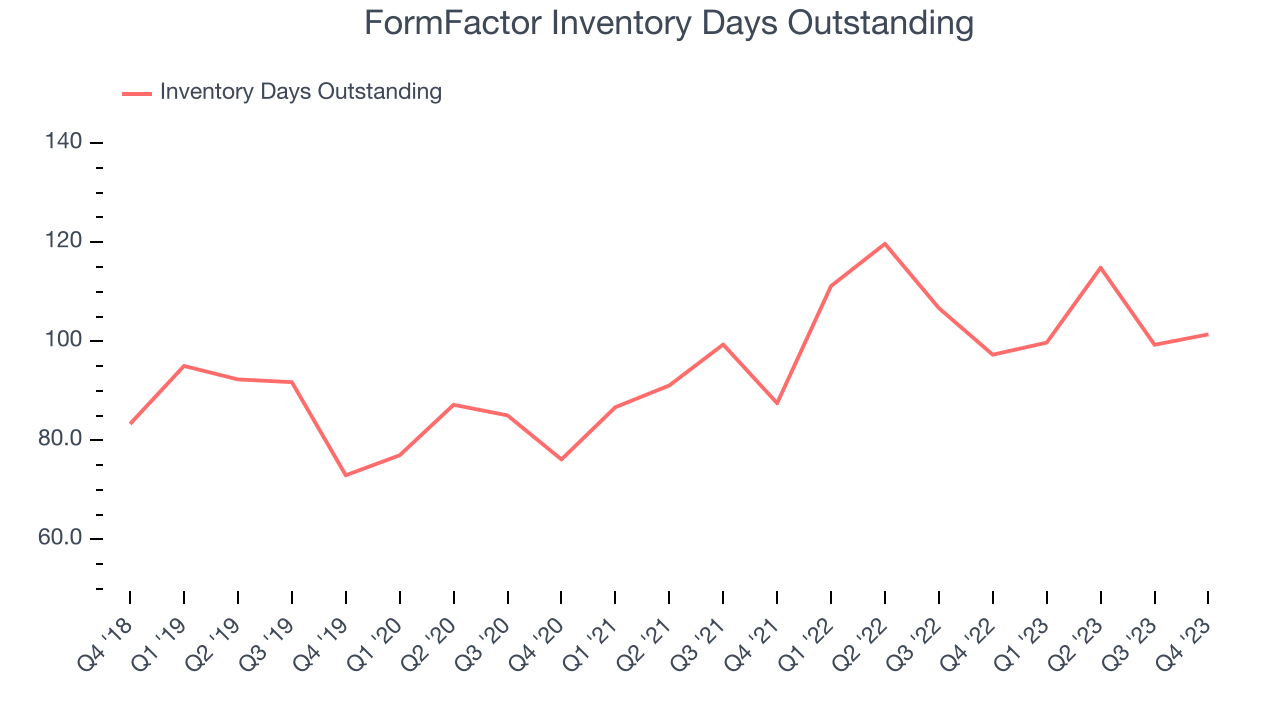
This quarter, FormFactor's DIO came in at 101, which is 7 days above its five-year average, suggesting that the company's inventory has grown to higher levels than we've seen in the past.
Pricing Power
In the semiconductor industry, a company's gross profit margin is a critical metric to track because it sheds light on its pricing power, complexity of products, and ability to procure raw materials, equipment, and labor. FormFactor's gross profit margin, which shows how much money the company gets to keep after paying key materials, input, and manufacturing costs, came in at 40.4% in Q4, up 9.8 percentage points year on year.
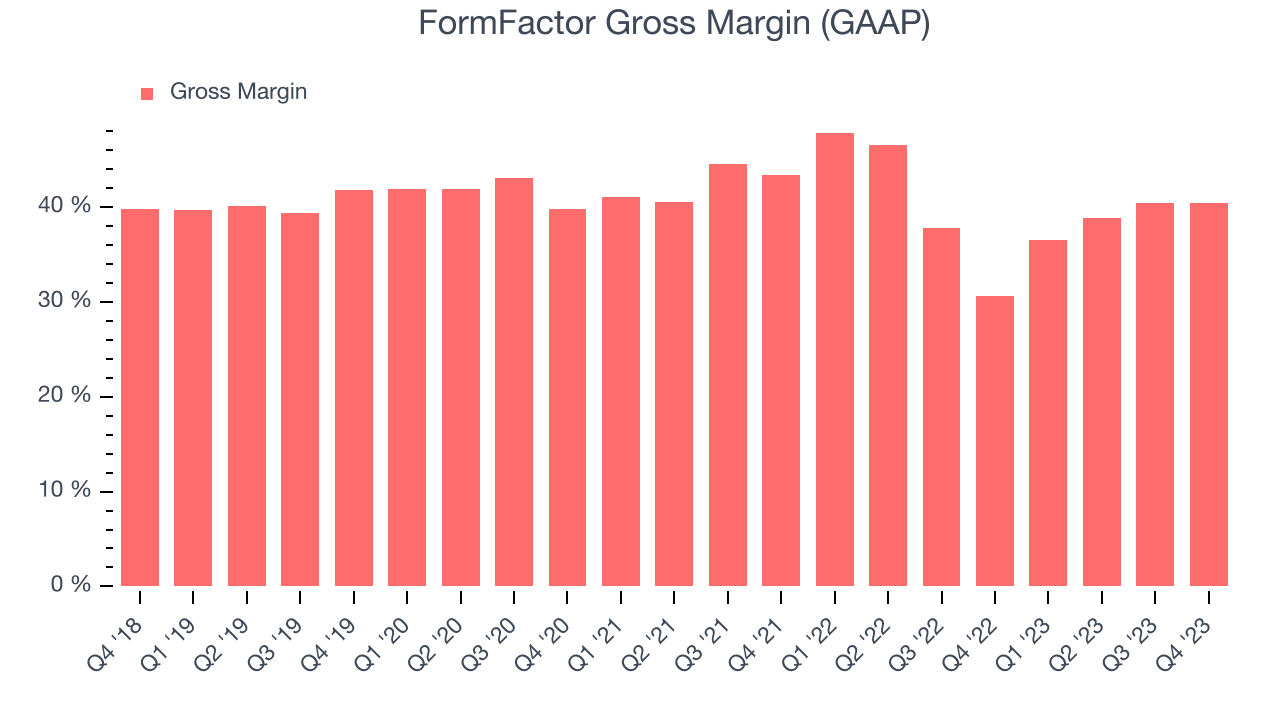
FormFactor's gross margins have been stable over the last 12 months, averaging 39%. Although its margins remain below the peer group average, the trend points to a likely stable pricing environment.
Profitability
FormFactor reported an operating margin of 11.4% in Q4, up 8.5 percentage points year on year. Operating margins are one of the best measures of profitability because they tell us how much money a company takes home after manufacturing its products, marketing and selling them, and, importantly, keeping them relevant through research and development.
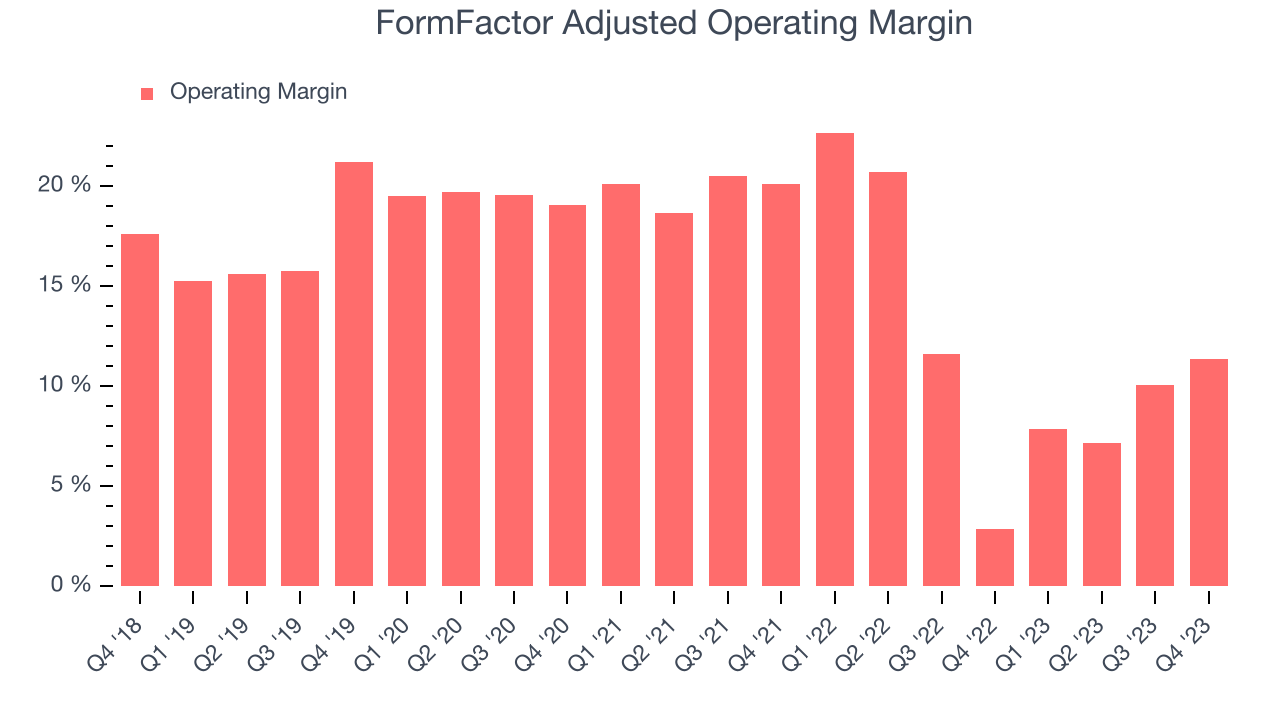
FormFactor's operating margins have been trending up over the last year, averaging 9.1%. This is a welcome development for FormFactor, whose cost structure isn't as efficient as it could be, as indicated by its slightly below-average margins.
Earnings, Cash & Competitive Moat
Analysts covering FormFactor expect earnings per share to grow 59.1% over the next 12 months, although estimates will likely change after earnings.
Although earnings are important, we believe cash is king because you can't use accounting profits to pay the bills. FormFactor's free cash flow came in at negative $310,000 in Q4, up 94.2% year on year.
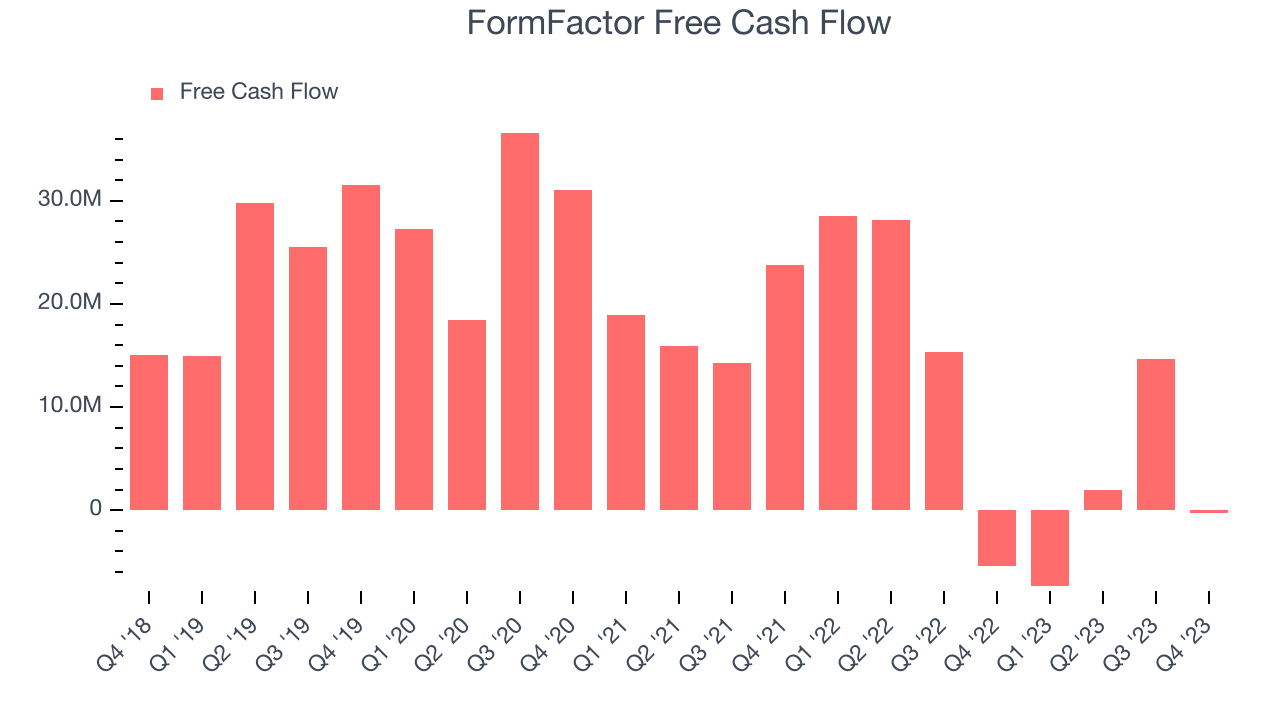
As you can see above, FormFactor produced free cash flow of just $8.95 million in the last year, resulting in a measly 1.3% free cash flow margin. FormFactor will need to improve its free cash flow conversion if it wants to stay competitive.
Return on Invested Capital (ROIC)
EPS and free cash flow tell us whether a company was profitable while growing revenue. But was it capital-efficient? Enter ROIC, a metric showing how much operating profit a company generates relative to how much money the business raised (debt and equity).
FormFactor's five-year average ROIC was 11.6%, somewhat low compared to the best semiconductor companies that consistently pump out 35%+. Its returns suggest it historically did a subpar job investing in profitable business initiatives.
The trend in its ROIC, however, is often what surprises the market and drives the stock price. FormFactor's ROIC has stayed the same over the last two years. If FormFactor wants to become an investable business, it will need to increase its returns.
Key Takeaways from FormFactor's Q4 Results
We were impressed by FormFactor's strong gross margin improvement this quarter. We were also glad its operating margin improved. On the other hand, its revenue guidance for next quarter slightly missed analysts' expectations and its EPS missed Wall Street's estimates. Overall, this quarter's results still seemed fairly positive and shareholders should feel optimistic. Investors were likely expecting more, however, and the stock is down 2.3% after reporting, trading at $37.21 per share.
Is Now The Time?
When considering an investment in FormFactor, investors should take into account its valuation and business qualities as well as what's happened in the latest quarter.
We cheer for everyone who's making the lives of others easier through technology, but in the case of FormFactor, we'll be cheering from the sidelines. Its revenue has declined over the last three years, and analysts expect growth to deteriorate from here. On top of that, its low free cash flow margins give it little breathing room, and its operating margins reveal subpar cost controls compared to other semiconductor businesses.
FormFactor's price-to-earnings ratio based on the next 12 months is 33.0x. While we have no doubt one can find things to like about the company, we think there might be better opportunities in the market and at the moment don't see many reasons to get involved.
Wall Street analysts covering the company had a one-year price target of $41 per share right before these results (compared to the current share price of $37.21).
To get the best start with StockStory check out our most recent Stock picks, and then sign up to our earnings alerts by adding companies to your watchlist here. We typically have the quarterly earnings results analyzed within seconds of the data being released, and especially for the companies reporting pre-market, this often gives investors the chance to react to the results before the market has fully absorbed the information.
